Table of Contents
Soils of India Introduction
Soil, a valuable resource, is the topmost layer of Earth’s crust. A thin layer of soil is formed on the surface of earth, by various processes of weathering and gradation of the parent rock material.
A soil is a mixture of rock debris and organic matter that forms on the earth’s surface. Relief, parent material, climate, vegetation, and other life forms all contribute to soil formation. Apart from these factors, human activities also have a significant impact on formation of soil. There are four elements in soil: minerals, humus, water, and air.
What is soil profile?
Soil is divided into layers of subsections which are called as “horizon“. For example, if we are able to dig a deep enough hole / pit in the ground, we will notice variations in colour of the soil. All these different coloured layers of soil are individually called horizons and all these horizons when considered together is called soil profile of that particular location.
Soil profile (layers of soil or cross section of soil) is depicted in the following diagram:

- A – Horizon : Topsoil, it is the topmost zone of the soil. It has the most amount of mineral matter, nutrients, and water, all of which are essential for the growth of plants. It is commonly used in combination with O-horizon(layer of organic matter such as plant residue often referred as humus).
- B – Horizon : Subsoil, a transition zone between A and C horizon, incorporates matter derived from both the horizons above and below ( The process of mixing of matter from one horizon to another is called “illuviation“) . Although the minerals are noticeably weathered, there is some organic matter in it along with the presence of clay, aluminium and iron.
- C – Horizon : This layer of soil has loose and weathered parent material. In the process of forming soil, this layer is the first step. It eventually forms the two layers above it (Horizon A and B).
- D – Horizon : Below the above mentioned three horizons is the bedrock, which is also known as the parent rock.
Factors effecting soils of India
- The parent rock or material from which regolith ( the layer of unconsolidated solid material covering the bedrock) is formed.
- Topography, such as steep slope, undulating slope or gentle slope, determines the thickness of the soil layer and also the probability of soil erosion.
- Climate such as wind, temperature and moisture.
- Type of vegetation grown on the location greatly effects the structure and colour of the soil.
History of classification of Soils of India
- A soil map of India was published in 1957 by the National Atlas Organisation Kolkata ( currently known as National Atlas & Thematic Mapping Organisation – NATMO), which declared that there are six major groups of soils of India and eleven broad types of soils of India.
- Soil of India can be broadly categorized into two types based on their geology:
1. Soils of peninsular India : These soils are formed by decomposition of in-situ rocks. These soils are less often , redistributed and re-transported and hence called sedentary soils.
2. Soils of extra-peninsular India : These types of soils are formed by movement and deposition of soils by river and winds. These types of soils are primarily found in river valleys and deltas. These types of soils constitutes some of the most fertile soils of India. This kind of soil is called transported or azonal soils. - US Department of agriculture – USDA (in 1960 with supplements in 1964 and 1967) developed 7th approximation (Soil Taxonomy – A Basic System of Soil Classification for Making and Interpreting Soil Surveys). This report was referred by National Atlas Organization (India), and S.P. Chatterjee authored Irrigation Atlas of India, which classified the soils of India.
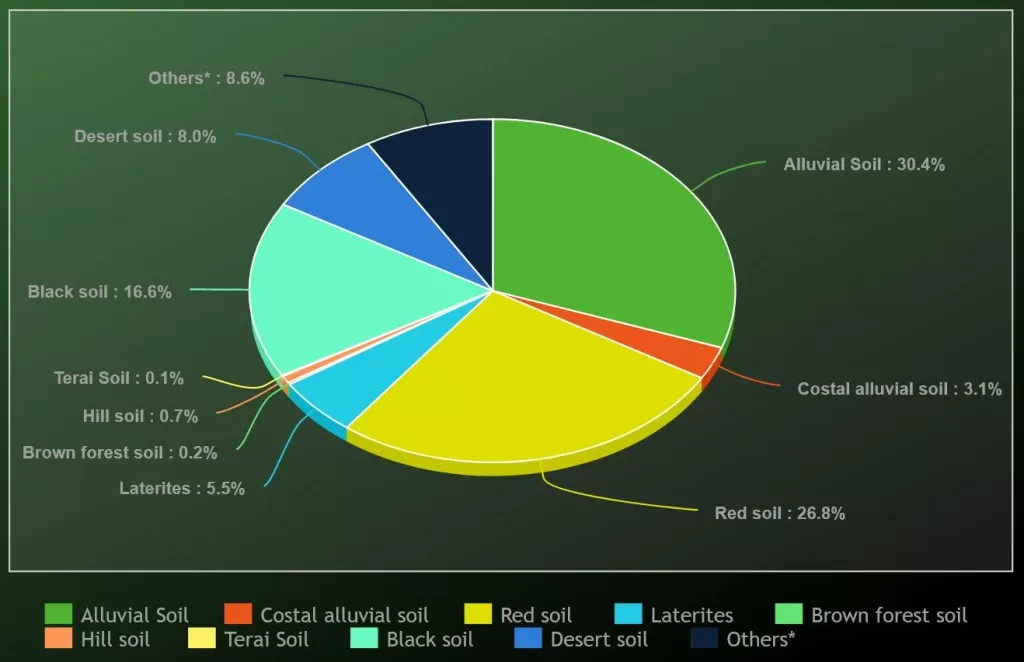
- 7th approximation defines soils of India based on its morphology and composition. The classification was: Inceptisols, Vertisols, Alfisols, Oxisols, Histosols, Ultisols, Podsols, mollisols, Entisols, Aridosols And Spodosols.

Ancient Classification of soils of India
In 16th century AD, soil was classified on the basis of inherent characteristics and external features. External features included colour, texture, moisture content of the soil and slope of the land.
Texture of the soil was further classified as clayey, silty, sandy and loam. Colour of the soil was further classified as black red or yellow.
In ancient times, soils of India were classified mainly in two catagories:
- Urvara : Fertile soil.
- Usara : Sterile soil or infertile soil.
Modern classification of soils of India
The National Bureau of Soil Survey and Land Use Planning – (NBSS&LUP), an institute constituted under Indian Council of Agricultural Research (ICAR), assisted ICAR in classification of Indian soil based on the standards laid out by United States Department of Agriculture (USDA) Soil Taxonomy.
| ICAR has classified the soils of India into the following order as per the USDA soil taxonomy | ||
|---|---|---|
| ORDER | AREA (in Thousand Hectares) | PERCENTAGE |
| Inceptisols | 130372.90 | 39.74 |
| Entisols | 92131.71 | 28.08 |
| Alfisols | 44448.68 | 13.55 |
| Vertisols | 27960.00 | 8.52 |
| Aridisols | 14069.00 | 4.28 |
| Ultisols | 8250.00 | 2.51 |
| Mollisols | 1320.00 | 0.40 |
| Others | 9503.10 | 2.92 |
| Total | 100 | |
| Source : Soils of India, National Bureau of soil survey and land Use Planning, publication Number 94 | ||
In 1956, All India Soil Survey Committee was formed by The Indian Council of Agricultural Research (ICAR). This committee categorized types of Indian soil in 8 major categories. These logical and widely accepted categorizations were made on the basis of the soil genesis, composition and location, and colour.
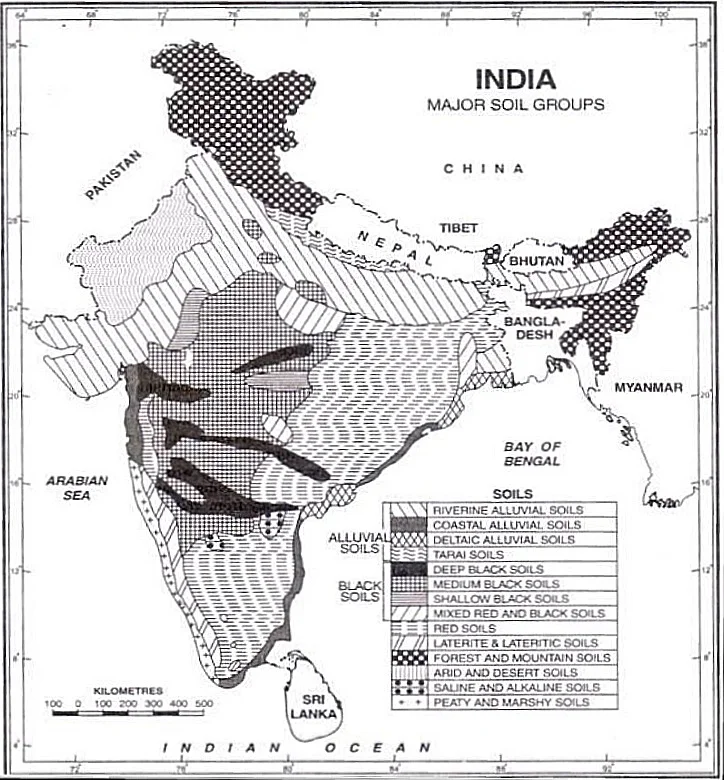
1. Alluvial Soils
- Alluvial soils are abundant in the northern plateaus and the river valleys in India.
- Approximately 40 percent of the total area of India is covered by alluvial soils.
- Alluvial soil is depositional soil, brought downstream and deposited by rivers and streams.
- They extend into the plains of Gujarat through a narrow corridor in Rajasthan. In the Peninsular region, they can be found in the deltas on the east coast and along the river valleys.
- The nature of the alluvial soils varies from sandy loam to clay.
- Generally, alluvial soil is rich in potash but poor in phosphorus.
- A variety of alluvial soils have emerged in the Middle and Upper Ganga plains, namely, Bhangar and Khadar.
Bhanger : Located away from the flood plains, Bangar represents an older alluvial deposit.
Khadar : Khadar is a new kind of alluvium that forms when floods deposit fine silts on top of the soil.
Khadar and Bhanger soils both contain calcareous concretions (Kankars). On the lower and middle Ganga plain, as well as in the Brahamaputra valley, the soils are more loamy and clayey. Sand content decreases from the west to the east.
Following is the comparison of Khadar and Bhanger alluvial soil:
| KHADAR | BHANGAR | |
|---|---|---|
| Definition | New alluvial deposits in Northern plains | Old alluvial deposits in Northern plains |
| Stability of deposit | Not stable | Stable |
| Location | Near the river bed | Away from river bed |
| Fertility | More fertile | less fertile |
| Renewal of deposit | Renews every year | Does not renew |
| Suitability for agriculture | More suitable | Less suitable |
| Concentration of Kankar on Calcium carbonate | Less | High |
| Texture | Coarse | Fine |
- Alluvial soils are generally light grey to ash gray in color. Shades are determined by the depth of the deposition, the texture of the materials, and the maturity period.
- The soils of alluvial plains are intensively cultivated.
2. Black soils
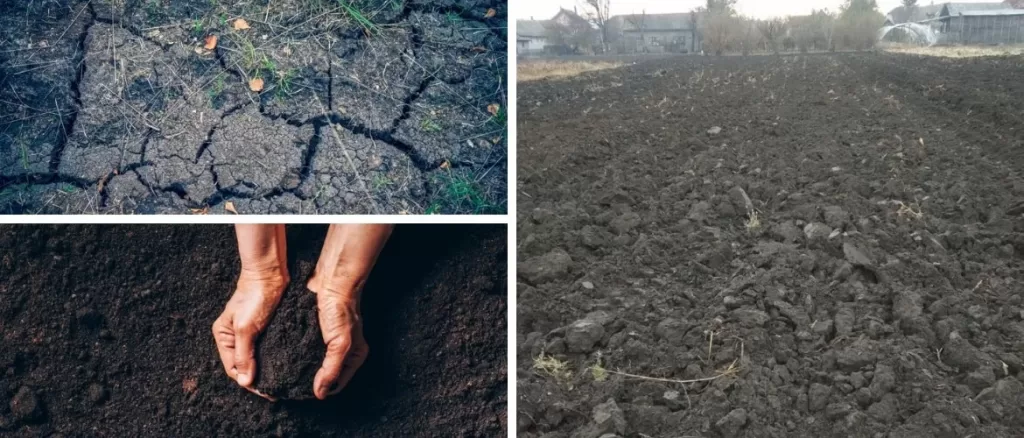
- Black soils are also called as the ‘Regur Soil’ or the ‘Black Cotton Soil’.
- Most of the Deccan Plateau is covered by black soil, which includes parts of Maharashtra, Madhya Pradesh, Gujarat, Andhra Pradesh, and some parts of Tamil Nadu.
- Black soil is particularly deep in the upper reaches of the Godavari and Krishna rivers, as well as the northwestern portion of the Deccan Plateau.
- Black soil is clayey, deep, and impermeable in texture.
- Black soil, when wet, swells and becomes sticky. It shrinks when dry. As a result, in dry season black soil has a tendency of developing wide cracks.
- The soil tends to “self-plough” due to loosening particles falling from the ground into the cracks. As a result, the soil absorbs moisture and retains it.
- Black soil can retain moisture for a very long time even during dry seasons, hence it is a preferable soil for cultivation of crops (especially rain fed crops)
- Black soil is rich in lime, iron, alumina and magnesia. Additionally, it contains potash.
- However, black soil lacks phosphorous, nitrogen, and organic matter.
- Black soil is deep black to grey in color.
3. Red and Yellow Soils
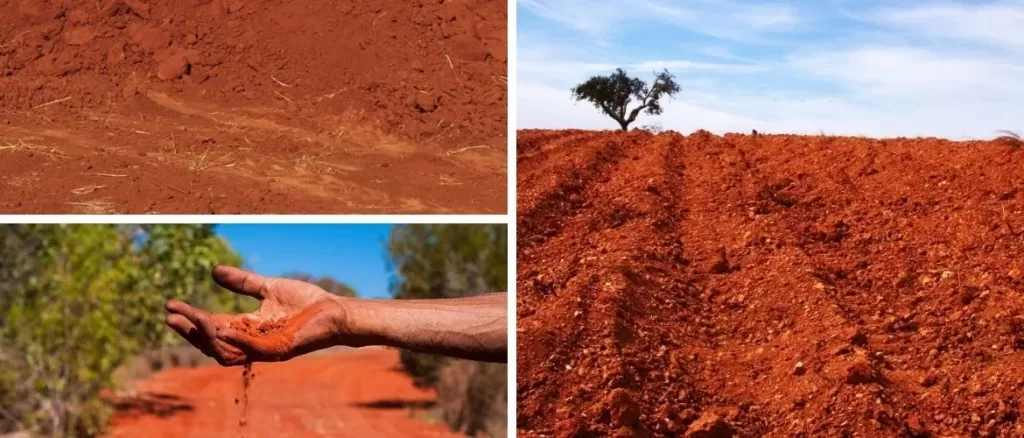
- Low rainfall areas of the eastern and southern Deccan Plateau produce red soil on crystalline igneous rocks.
- Long stretches of red loamy soil occupy the piedmont zone of the Western Ghat.
- Red and yellow soils can also be found in parts of Odisha and Chattisgarh, as well as in the southern part of the middle Ganga plain.
- Due to the diffusion of iron in crystalline and metamorphic rocks, soils develop a reddish color.
- When red soil is hydrated, it appears yellow.
- A fine-grained red or yellow soil is usually fertile, whereas coarse-grained soils found in dry upland areas are generally infertile.
- In general, red and yellow soil is deficient in nitrogen, phosphorus, and humus.
- Red soils are rich in Iron and are slightly acidic.
- Ragi, groundnuts, millets, tobacco, and potatoes grow well in these soils.
- Provided the fields are well irrigated, they can be used for a variety of crops.
- Red and yellow soils vary greatly in texture from loam to clayey loam.
4. Laterite Soils

- Laterite is derived from the Latin word “later”, which means brick.
- Generally, laterite soils form in areas with high temperatures and high rainfall (typically tropical countries like India with alternating wet and dry conditions). Due to tropical rains, these soils are the result of extensive leaching.
- When it rains, lime and silica are leached away, and iron oxide and aluminium compounds remain behind in the soil.
- Bacteria that thriving in high temperatures, quickly remove the humus content of the soil.
- Laterite soils have low levels of organic matter, nitrogen, phosphate and calcium, and high levels of iron oxide and potash.
- Laterites are not suitable for cultivation; however, manures and fertilisers can make the soils fertile for cultivation.
- In Tamil Nadu, Andhra Pradesh and Kerala, red laterite soils are better suited to tree crops like cashewnuts trees.
- Laterite soil can also be used for cultivation of rubber, coffee, tea or rice.
- Laterite soil is widely used to make bricks for construction.
- Generally, these soils have developed in the higher areas of the Peninsular plateau. Karnataka, Kerala, Tamil Nadu, Madhya Pradesh, the hilly areas of Odisha, and Assam commonly have laterite soils.
- Laterite soil is acidic in nature in elevated areas and inefficient in retaining moisture.
- It has got a heavy loam to clayey texture on the plains.
5. Arid Soils or Desert soils
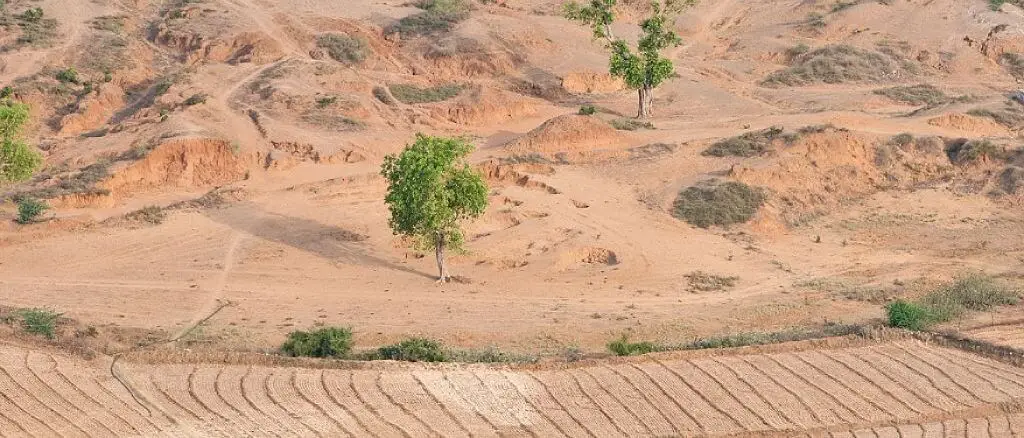
- Arid soils range in color from red to brown.
- In general, they have a sandy structure and are saline in nature.
- In some regions, the salt content is so high that common salt can be obtained by evaporating the saline water.
- As a result of the dry climate, high temperatures, and rapid evaporation, they lack moisture and humus.
- In arid soils, Phosphate content is normal, but nitrogen is insufficient.
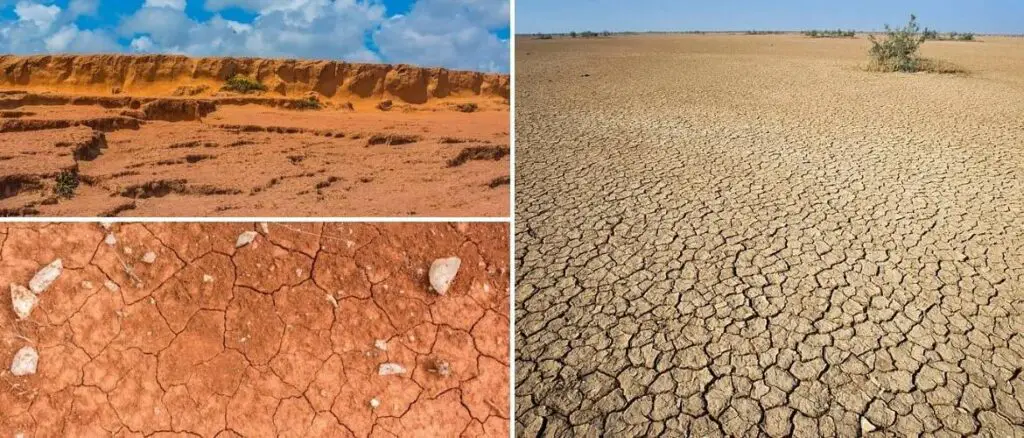
- Since the calcium content of the soil increases downward, the lower horizons of the soil are occupied by “kankar” layers.
- The ‘Kankar’ layer formation in the bottom horizons restricts the further seeping down of water to below horizons, this greatly assists the soil in retaining higher soil moisture content.
- Arid soils are characteristic of western Rajasthan, which has a typical arid topography.
- Generally, arid soils are poor, humus-free, and devoid of organic matter.
6. Saline Soils or Alkaline Soils
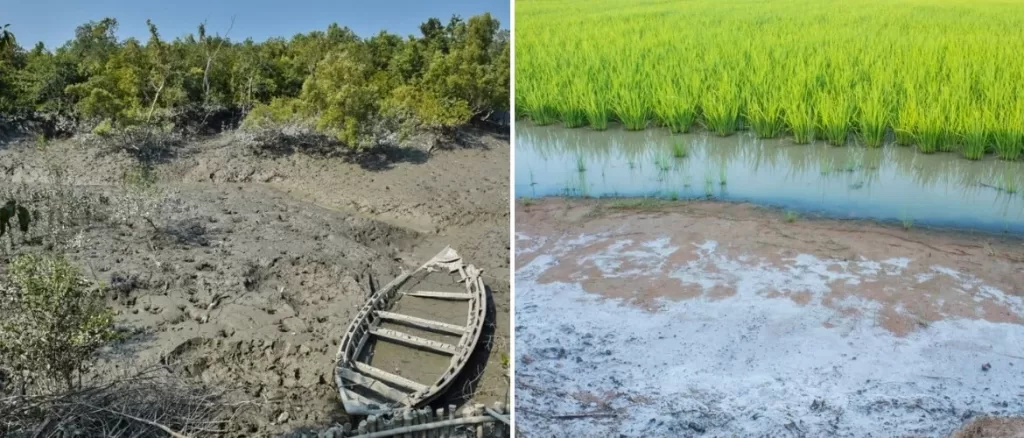
- Saline soils are also known as Usara soils (Sterile soil or infertile soil).
- As saline soils contain high levels of sodium, potassium, and magnesium, they are infertile and unable to support vegetative growth.
- As a result of the dry climate and poor drainage, saline soils have more salts. They are found in arid and semi-arid regions, as well as swampy and waterlogged areas.
- Saline soil texture varies from sandy to loamy.
- Saline soil is deficient in nitrogen, phosphorous and calcium. However, saline soil has high organic matter content.
- Saline soils are strongly acidic.
- It is more common to find saline soils in West Bengal, the eastern coast deltas, and Gujarat’s western region. The Southwest Monsoon deposits salt particles and forms a crust in the Rann of Kuchchh.
- In the deltas, seawater intrusions promote the development of saline soils.
- The fertile alluvial soils are becoming saline in areas of intensive cultivation and excessive irrigation, particularly in areas of the green revolution.
- An excessive amount of irrigation in a dry climate promotes capillary action, which results in salt forming on the surface of the soil. The problem of salinity in soils is usually solved by adding gypsum to such areas, especially in Punjab and Haryana.
7. Peaty Soils
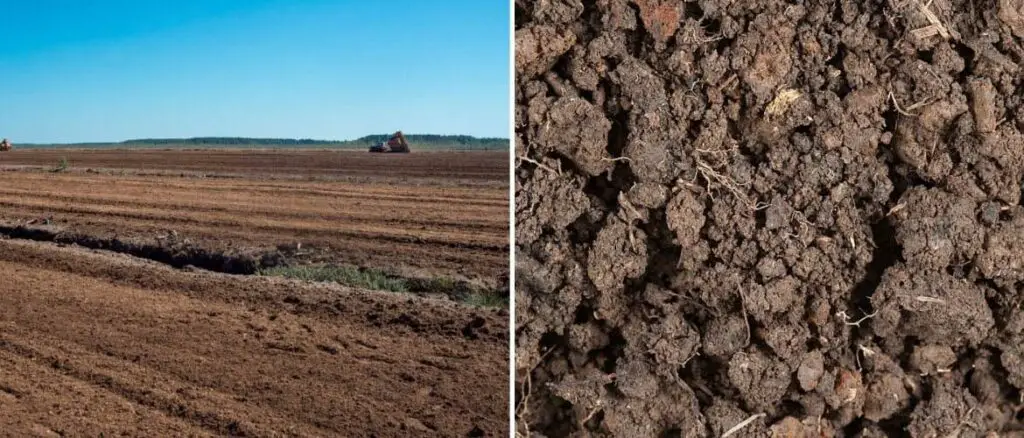
- Peaty soils are found in areas with heavy rainfall and high humidity, where vegetation is abundant. Consequently, large amounts of dead organic matter accumulate in these areas, and this gives the peaty soil a rich humus and organic content.
- Peaty soils may contain as much as 40-50 percent organic matter.
- In general, these soils are heavy and black in colour. They can also be alkaline in many geographical locations.
- Peaty soil is abundant in the northern part of Bihar, the southern part of Uttaranchal, and the coastal areas of West Bengal, Orissa, and Tamil Nadu.
- Peaty soil is fine in texture.
- Due to decomposition of organic matter in anaerobic conditions, the pH level of peaty soil ranges between 3.5 to 4 (strong acidic due to content of ferrous and aluminum sulphates).
8. Mountain Soils or Forest Soils
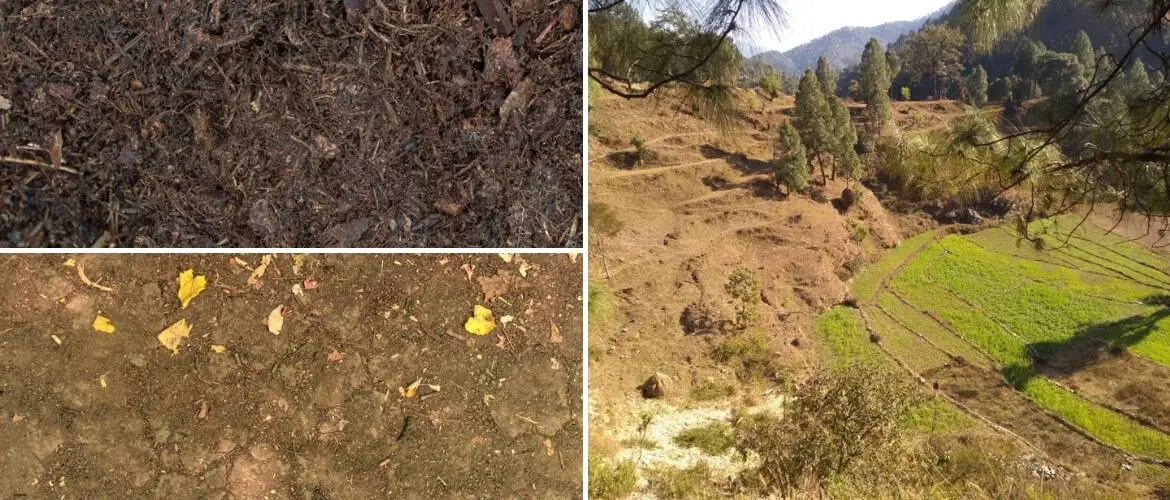
- As implied by the name, forest soil is formed in areas of forest where there is sufficient rainfall.
- Also as implied by the name, mountain soil is termed so because it is found on the slopes of mountains and hills
- Based on the mountains where the soils are found, soils vary in texture and structure.
- In the valley sides, mountain soil tends to be loamy and silty, while in the upper slopes, mountain soil may be coarse-grained.
- Montain soil is acidic and low in humus in the snowy regions of the Himalayas.
- Lower valleys of the mountain have fertile forest / mountain soils.
- Forest soil usually has a brown color with a clayey silty texture and a moderate acidity level.
- Their highly fertile nature makes them ideal for the growth of plantation crops such as tea, coffee, spices, and tropical fruits.
- In India, forest or mountain soil is prevalent in Jammu & Kashmir, Himachal Pradesh, Manipur, Western Ghats in Karnataka, Kerala, and Tamil Nadu.
State-wise distribution of soils of India
Following table represents state-wise distribution of soils of India. It also depicts certain characteristics (such as content availability in the soil and preferred crop to grow on the soil).
| SOIL TYPE | SURPLUS MINERALS / ELEMENTS | DEFICIENT MINERALS / ELEMENTS | RECOMMENDED CROP | INDIAN STATE |
|---|---|---|---|---|
| Alluvial Soils | Potash, Lime | Nitrogen, Phosphorus, Organic matter | Rice, Wheat, Sugarcane, Tobacco, Cotton, Jute, Maize, Oilseeds, Vegetables, Fruits | Plains of Gujarat, Punjab, Haryana, UP, Bihar, Jharkhand |
| Black soils | Lime, Iron, Magnesia, Alumina, Potash | Nitrogen, Potassium, Phosphorous, Humus | Cotton, Wheat, Jowar, Linseed, Virginia tobacco, Castor, Sunflower, Millets | Deccan plateau- Maharashtra, Madhya Pradesh, Gujarat, Andhra Pradesh,Tamil Nadu, Valleys of Krishna and Godavari. |
| Red and Yellow Soils | Iron, Potash | Nitrogen, Humus, Phosphoric acid, Magnesium, Lime | Cotton, Wheat, Rice, Pulses, Millets, Tobacco, Oilseeds, Potatoes, Fruits | Parts of Tamil Nadu, Southern Karnataka , South-East Maharashtra, parts of Madhya Pradesh, Goa, Kerala, Orissa, Bihar, West Bengal, Uttar Pradesh, Eastern Parts of Rajasthan, Assam, Manipur, Tripura, Meghalaya and Nagaland |
| Laterite Soils | Iron oxide, potash, Aluminum, Titanium, Manganese oxides | Nitrogen, Phosphorus, Potassium, Lime, Magnesia, Organic matter, Calcium | Tea, Coffee, Cashew, Rubber | Karnataka, Kerala, Tamilnadu, Madhya Pradesh, Assam and Orissa hills. |
| Arid Soils or Desert soils | Sodium, Phosphate, Gypsum, calcium carbonates | Humus, Nitrogen | Barley, Cotton, Wheat, Millets, Maize, Pulses | Western Rajastan, north Gujarat and southern Punjab |
| Saline Soils or Alkaline Soils | Sodium, Potassium, Magnesium | Nitrogen, Calcium, Phosphorus | Date palm, Barley, Sugarbeet, Cotton, Asparagus, Spinach | Western Gujarat, deltas of eastern coast, Sunderban areas of West Bengal, Punjab and Haryana |
| Peaty Soils | Aluminum Sulphates, Carbon, Nitrogen | Copper, Boron, Zinc | Potatoes, Sugarbeet, Celery, Onions, Carrots, Lettuce, market garden crops, Willows | Orissa, Sunder-bans in West Bengal, parts of Bihar, Uttar Pradesh and Kottayam, Alleppey, districts of Kerala |
| Mountain Soils or Forest Soils | Phosphorus, Calcuim, Magnesium, Pottassium, Sulfur, Manganese | Phosphorus, Potash, Lime | Rice, Tea, Beans corn, Squash, Vegetables | Jammu & Kashmir, Himachal Pradesh, Manipur, W estern Ghats in Karnataka, Kerala and Tamil Nadu |

